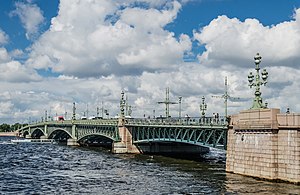Troitsky Bridge
Coordinates: 59 ° 56 ′ 56 ″ N , 30 ° 19 ′ 39 ″ E
| Troitsky Bridge | ||
|---|---|---|
| Troitsky Bridge | ||
| Official name | Троицкий мост | |
| use | Motor vehicles, trams, pedestrians | |
| Crossing of | Neva | |
| place | Saint Petersburg , (Russia) | |
| overall length | 582 m | |
| width | 24 m | |
| Longest span | 43 m | |
| start of building | 1897 | |
| completion | 1903 | |
| opening | 1903 | |
| planner | Paul Bodin | |
| location | ||
|
|
||
The Troitski Bridge ( Russian Троицкий мост Troitski most , "Trinity Bridge") crosses the Neva in Saint Petersburg . During the Soviet Union it was called the Kirov Bridge (the Communist Party functionary lived from 1886 to 1934). It connects the Field of Mars with Troitsky Square on the Petrograd side .
The Pulkowo meridian runs along the axis of the bridge .
Building history
In 1892 a competition for the construction of the bridge was announced. Although Gustave Eiffel's company won the 6,000 ruble prize money , the bridge was then built by another French company, Société de Construction des Batignolles (now Spie Batignolles ), which did not take part in the competition.
Construction began on August 12, 1897, with the laying of the foundation stone by the then French President Félix Faure . In 1903, just in time for the 200th anniversary of St. Petersburg, the bridge was completed. It was the third, permanent bridge over the Neva.
Originally the bridge consisted of nine arches. The three-arched granite viaduct on the right bank of the Neva is followed by five metal arches, and on the left bank was a two-part bascule bridge. This was replaced in 1965-67 by a new, 43-meter-wide bascule bridge, in the same style as the existing metal arches, and a large granite arch.
See also
literature
- Boris Piotrowski among others: Sankt-Peterburg, Petrograd, Leningrad: enziklopeditscheski sprawotschnik . Bolschaja rossijskaja enziklopedija, Moscow 1992, ISBN 5-85270-037-1 (Russian)
Web links
- Troitsky Bridge in the online encyclopedia Saint Petersburg (English, Russian )
- The Trinity Bridge in Saint Petersburg, Russia .

